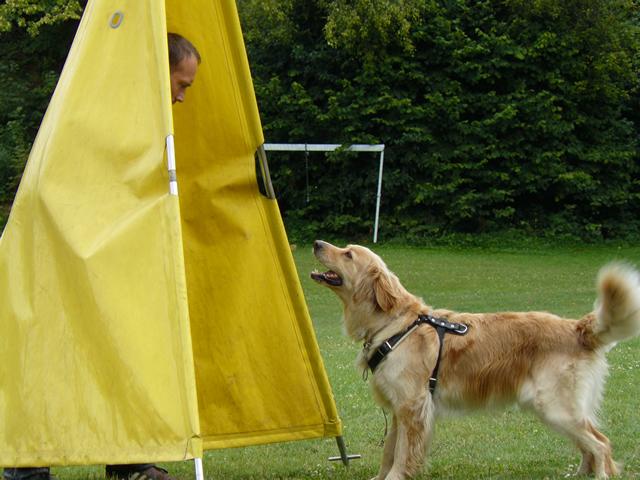- Hovawart
Infobox Dogbreed
country =Germany
fcigroup = 2
fcinum = 190
fcisection = 2
fcistd = http://www.google.com/search?q=cache:CNxOYvllbOkJ:www.fci.be/uploaded_files/190A2002_en.doc+http://www.fci.be/uploaded_files/190A2002_en.doc&hl=en&gl=ca&ct=clnk&cd=1

image_caption = A blond working Hovawart
kcukgroup = Working
kcukstd = http://www.thekennelclub.org.uk/item/53
ckcgroup= Group 2 - Working
ckcstd=http://www.ckc.ca/en/Default.aspx?tabid=99&BreedCode=HVW
name = Hovawart
note = The UKC does not have an official breed standard
ukcgroup = Guardian Dogs
ukcstd = ?
nickname= HovieThe Hovawart is a German
dog breed . The name of the breed means "an estate guard dog," which is the original use for the breed. The breed originated in theBlack Forest region and was first described in text and paintings in medieval times.Description
Appearance
The Hovawart is a medium dog. Male Hovawarts are 63-70 cm (25"-27 1/2") and bitches (female) 58-65 cm (23"-25 1/2") at the
withers . The weight is approximately 25-40 kg (55-90 pounds). The correct color descriptions are Black, Black and Gold, and Blond.Temperament
The Hovawart is an outstanding watch dog and somewhat reserved towards strangers. They make excellent family dogs as they are totally devoted to their family. They are a working dog breed, and require a consistent and loving yet strict training and meaningful activity throughout their lives.
History
Thirteenth century
One of the first documented recordings comes from the year 1210 when the German castle
Ordensritterburg was besieged by Slavic invaders. The castle fell and its inhabitants including the Lord were slaughtered, however the Lord's infant son was saved by one of the castle's Hovawarts. In spite of being wounded itself, the dog dragged the tiny child to a neighbouring castle and thus saved the boy's life. This young boy,Eike von Repkow , grew up to become a legendary figure in the history of German law. He later published theSachsenspiegel , the oldest Code of Law to survive from medieval Germany. Not surprisingly, the Hovawart is mentioned with praise. TheSchwabenspiegel , a law text published in 1274 and based on Eike von Repkow's Sachsenspiegel, lists the Hovawart among the dogs you have to replace and payrestitution for if they are killed or stolen.Fifteenth century
By 1473,
Heinrich Mynsinger described the Hovawart as one of "The Five Noble Breeds" and among its uses listed that it was useful for tracking the robber and miscreant. This along with references to the Hovawart in German law show that it was a readily identifiable breed and held in similar esteem to that of hunting dogs.Twentieth century
Following the medieval period, the popularity of the Hovawart began to decline. Newer breeds such as the
German Shepherd slowly replaced the Hovawart as a guard and working dog until it had almost disappeared by the beginning of the twentieth century. Around 1915 a group of enthusiasts decided to try and save the breed. Predominant in this group was thezoologist "Kurt Friedrich König ." They started by looking for dogs in the farms of theBlack Forest region. König then started a careful breeding program using these dogs and crossed them withKuvasz ok, Newfoundlands, German Shepherds,Leonberger s, aBernese Mountain Dog and anAfrican Hunting Dog . After much work the group was rewarded in 1922 when the first Hovawart litter was entered into the German Breeding Registry. The enthusiasts continued their work and in 1937 theGerman Kennel Club officially recognised the Hovawart. All this work was almost undone with the outbreak of theSecond World War . Because of their abilities many Hovawarts were used in the German war effort and perished. By 1945 only a few remained. Enthusiasm for the breed remained and in1947 ,Otto Schramm and some fellow enthusiasts inCoburg formed a new club, the "Rassezuchtverein für Hovawart-Hunde Coburg" which is still in existence today. In 1964 the German Kennel Club recognised the Hovawart as the country's seventh working breed and around this time enthusiasm for the breed started to develop in other countries.Miscellaneous
The Hovawart does exceptionally well in
search and rescue , tracking and working dog activities. The females are generally lighter in build and often love agility. In training and especially obedience work the trainer must keep positive reinforcement in mind all the time, as the Hovawart is not as eager to please as many other working dog breeds. It is important to realize that the Hovawart works "with" you and not "for" you. They do have the ability to think and act independently. Their guarding instinct for example does not require any real training, it is inherent, its what they were bred for. The Hovawart may easily become reluctant if training is built only on punishments.The owner of a Hovawart should ideally have previous experience in owning and training a dog and as such the Hovawart is not usually suitable as a first dog.
External links
* [http://www.hovawartclub.nl/1-HCN-ENG/index-eng-hcn.htm Netherlands: The Hovawart Club of the Netherlands]
* [http://www.hovawart.org/ Germany: Rassezuchtverein für Hovawart-Hunde e.V.]
* [http://www.suomenhovawart.fi/ Finland: Suomen Hovawart Ry]
* [http://www.hovawart.org.uk/php The UK: The Hovawart Club of Great Britain]
* [http://www.hovawart.cz/ Czech Republic: Hovawart klub České republiky]
* [http://www.hovawarty.sk/ Slovakia: Slovenský Hovawart klub (SHK)]
* [http://www.hovawartklubben.se/ Sweden: Swedish hovawartclub]
* [http://www.hovawart.be/ Belgium: Belgische Hovawart Club]
Wikimedia Foundation. 2010.
